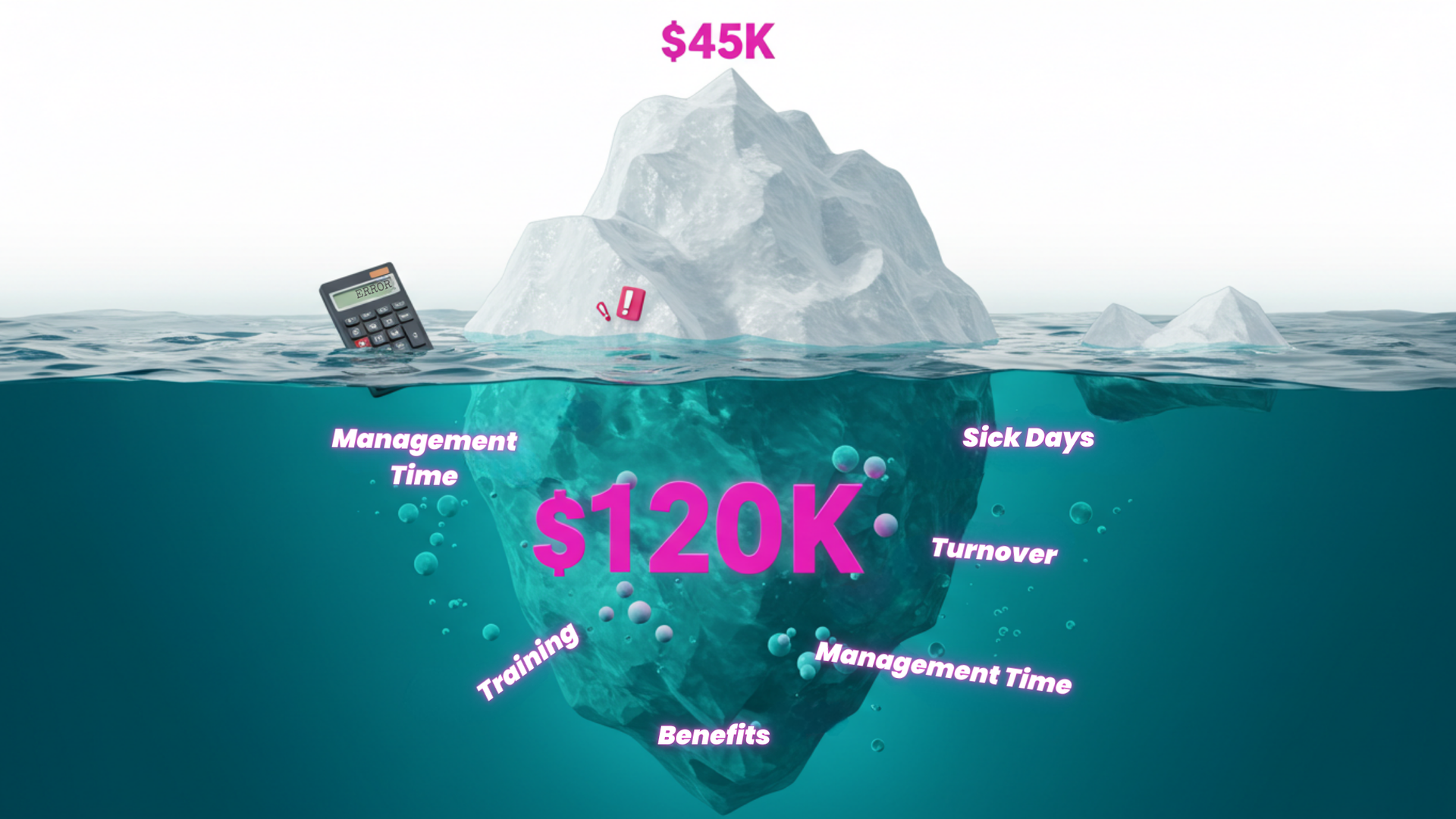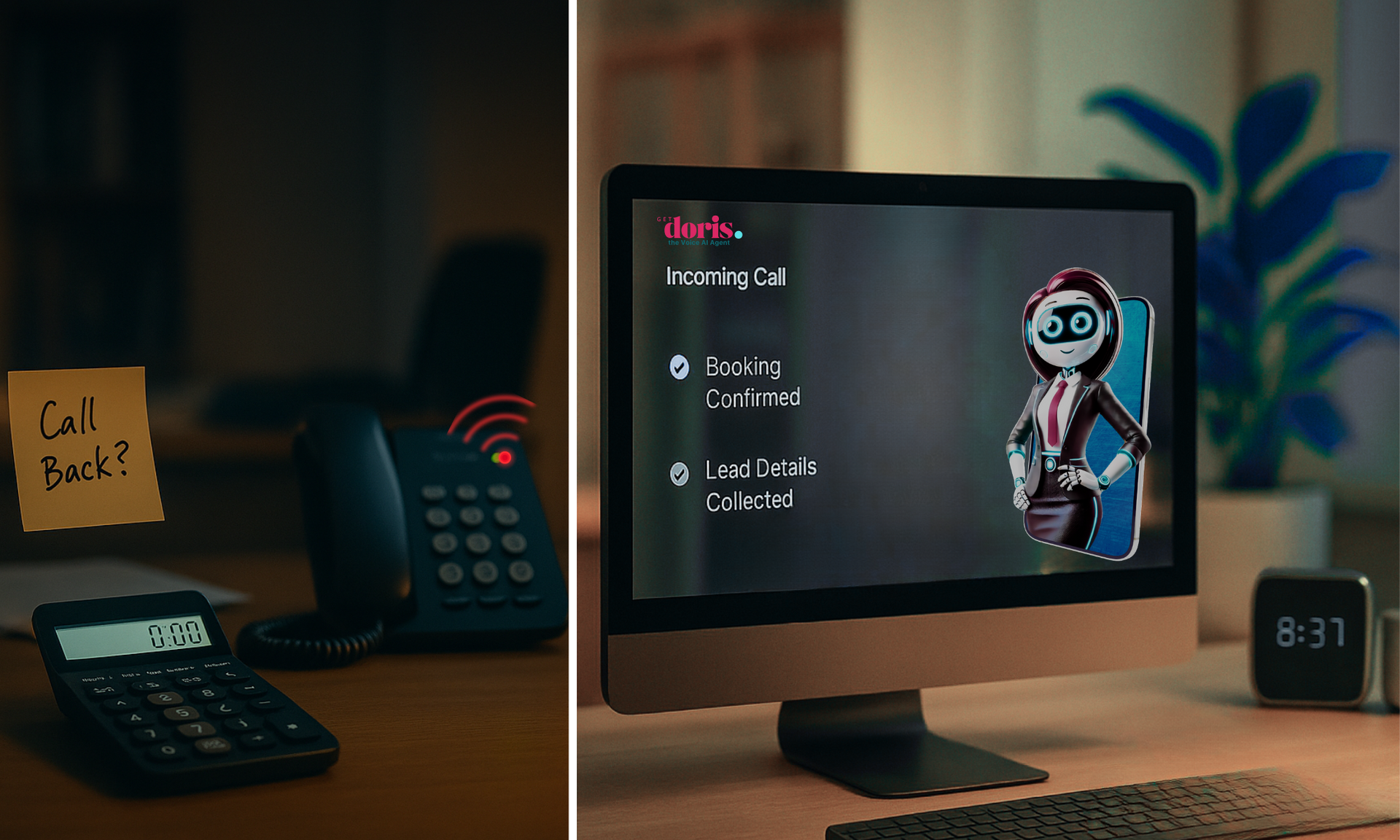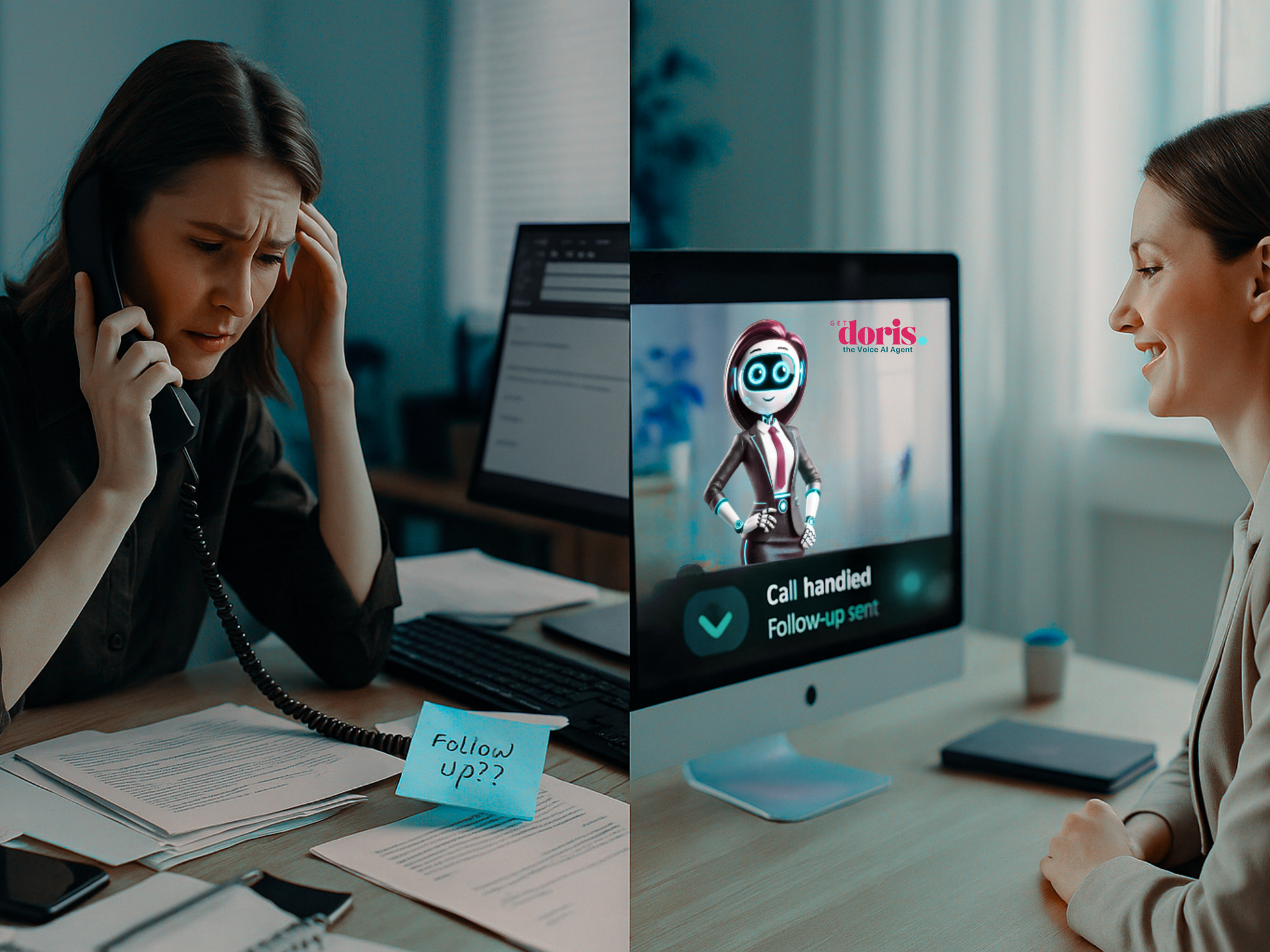Growth Without Collapse: How to Scale Your Business Without Working Yourself to Death
It's the paradox every successful business owner eventually faces.
You've worked relentlessly to grow your business. More clients, more projects, more revenue. And then, just when things should be getting easier, you find yourself working longer hours, drowning in admin, and wondering if success is supposed to feel this exhausting.
The harsh reality? Most businesses are built on manual processes that work perfectly fine at startup scale but become complete anchors when growth hits. What once felt manageable—answering calls, scheduling appointments, following up with leads—suddenly consumes every waking hour.
We see it everywhere. The dentist who spends evenings catching up on patient communications. The tradesperson who misses family dinner to return the day's calls. The consultant whose business is thriving but whose personal life is in shambles.
But here's what successful scaling looks like: the businesses that grow sustainably don't just work harder or hire more people. They systematically eliminate the bottlenecks that turn growth into a nightmare. And increasingly, they're doing it with AI solutions that handle the routine work, so humans can focus on what actually grows the business.
The Scalability Crisis: When Success Becomes Your Biggest Problem
Let's be honest about what really happens when most small businesses start to grow.
Picture this scenario: a financial advisory firm doubles their client base in 18 months—exactly what they'd been aiming for. But instead of celebration, the owner finds themselves in a state of near-burnout, working 70-hour weeks, and considering actually turning away new business.
This scalability crisis happens because most businesses operate with what we call "human-dependent systems"—processes that require direct human intervention at every step. These systems have hidden scale limitations that only become apparent when growth hits.
According to HubSpot's 2024 Service Report, service professionals save more than 2 hours a day using AI to respond to customers quickly, yet most small businesses still rely entirely on manual processes that simply don't scale.
The telltale signs you're facing a scalability crisis:
Your workload increases linearly with revenue. In a properly scalable business, revenue should grow faster than workload. When they grow in lockstep, you've got a fundamental problem. Consider a law firm that increases revenue by 40%, but their administrative hours grow by 65%. That's not sustainable growth—it's a recipe for burnout.
You've become the bottleneck in your own business. When more decisions and processes have to flow through you personally, you're constraining your company's growth potential. Healthcare providers often find themselves spending over 20 hours weekly just approving routine matters that don't actually need their expertise.
You're constantly in reactive mode. When your days are consumed by responding to calls and emails rather than strategic work, you're stuck in an unsustainable cycle. Trade business owners frequently discover that 70%+ of their time is spent reacting to client communications rather than on revenue-generating work.
Your customer experience is deteriorating. When growth leads to longer response times and more errors, your reputation starts suffering. Professional services firms often see their average email response time balloon from hours to days as they grow without systems to handle the volume.
You're avoiding growth opportunities. The ultimate red flag—when you stop marketing because you simply can't handle more volume. Successful consultants sometimes find themselves stopping all marketing efforts and even referring potential clients elsewhere because their practice has reached its operational ceiling.
The root cause behind all these symptoms is the same: manual processes that simply don't scale. When every new client requires the same amount of human effort as the last, you eventually hit a wall.
Why Traditional Growth Solutions Often Make Things Worse
If you've tried to solve these scaling challenges before, you've likely discovered that common approaches often create as many problems as they solve.
Adding more staff increases overhead before revenue catches up, creates new management burdens, and typically doesn't solve the underlying process inefficiencies. Professional services firms that double their administrative teams often find their processes actually slow down due to increased communication complexity and inconsistent execution.
Working longer hours yourself is obviously unsustainable. It leads to burnout, damages relationships, and eventually hits a hard ceiling—there are only so many hours in a day. Successful accountants working 80-hour weeks during tax season can develop stress-related health problems that force them to scale back their thriving practices.
Hiring contractors or VAs requires significant training time, often lacks integration with your core systems, and rarely solves the fundamental process inefficiencies that are the root cause. Consulting businesses often find that the time spent explaining their business processes to virtual assistants exceeds the time saved.
Patching with multiple software tools creates a new problem where data becomes fragmented across platforms, systems rarely integrate seamlessly, and your tech stack becomes increasingly complex to manage. Healthcare practices can accumulate dozens of different software subscriptions, creating fragmented experiences for both staff and patients, with critical information scattered across disconnected systems.
These approaches all share a common flaw: they attempt to optimize fundamentally unscalable processes, rather than reimagining how the work could be done differently.
The AI Solution: Choose Your Level of Automation
The businesses that successfully scale without corresponding increases in workload don't just work harder—they systematically automate the routine tasks that consume their time. Modern AI technology offers three progressive levels of automation to match where you are and where you want to go.
Level 1: AI Call Handler - Never Miss Another Opportunity
If missed calls are costing you business, this is your starting point. Research shows that most customers won't wait long for a response, and an AI call handler ensures every call is answered professionally, 24/7.
What it does:
- Answers all calls with natural, personalized conversations
- Captures complete caller information and intent
- Books appointments directly into your calendar
- Handles basic questions about your services
- Forwards urgent matters while managing routine inquiries automatically
Perfect for: Service businesses losing opportunities to missed calls—tradespeople, healthcare practices, professional services.
Level 2: AI Business Assistant - Your Complete Virtual Receptionist
When you need more than call handling, an AI business assistant becomes your full-service virtual receptionist, managing all customer interactions across channels.
What it includes:
- Everything from call handling, plus:
- Email and text message management
- Comprehensive appointment scheduling and rescheduling
- Lead qualification and nurturing
- Customer service inquiries across all channels
- Integration with your existing business systems
Perfect for: Growing businesses ready to automate their entire front office—medical practices, law firms, consulting services.
Level 3: AI Growth Engine - Complete Business Automation
For businesses ready to scale aggressively, a comprehensive AI growth engine provides automation that transforms your entire operation.
What it includes:
- Everything from business assistant functionality, plus:
- Advanced marketing automation and lead generation
- Customer retention and upselling campaigns
- Detailed analytics and business intelligence
- Custom workflows for your specific industry
- Strategic optimization recommendations
Perfect for: Established businesses ready for rapid, sustainable growth—healthcare groups, legal practices, financial services.
Choose Your Growth Path
The beauty of progressive AI automation is that you can start where it makes sense for your business and scale up as you grow.
Start with AI call handling if:
- You're missing calls and losing business
- You want immediate ROI with minimal complexity
- You're not ready for comprehensive automation
Move to business assistant level when:
- You're ready to automate beyond just phone calls
- You want to eliminate most routine customer interactions
- You're experiencing growth constraints across multiple channels
Upgrade to full automation when:
- You're ready for aggressive, sustainable scaling
- You want comprehensive business intelligence
- You're prepared to transform your entire operation
What This Means for Your Daily Reality
Let me paint a picture of how your typical day transforms at each level.
Before AI automation: You arrive to find 17 voicemails and 43 emails requiring responses. Your day is consumed by returning calls, answering basic questions, and playing scheduling phone tag. Strategic work gets pushed to evenings and weekends. Each new client creates more administrative overhead, more coordination challenges, and more demands on your limited time.
With AI call handling: You arrive to find all calls have been handled and new appointments already scheduled in your calendar. You can focus on actual service delivery rather than coordination. Businesses typically see immediate time savings of 10-15 hours weekly.
With AI business assistant: All routine communications are handled across every channel. Client inquiries get instant responses day or night. Your calendar manages itself with automatic scheduling and confirmations. You gain 20-25 hours weekly for high-value work that actually grows your business.
With comprehensive AI automation: Not only are operations automated, but you have complete business intelligence showing exactly where opportunities exist. Marketing happens systematically based on data rather than guesswork. Growth becomes predictable rather than chaotic. You work fewer hours while growing faster, with complete visibility into what's driving results.
The Results Businesses Are Achieving
According to McKinsey's latest research, 65% of organizations are regularly using AI in at least one business function, up from 33% the previous year. The businesses implementing AI automation are seeing transformational results.
Industry examples show:
Dental practices can increase patient capacity by 40-50% without adding administrative staff, with patient satisfaction scores improving because of faster, more consistent responses across all communication channels.
Plumbing businesses that implement call handling see 20-30% revenue increases in just a few months by never missing opportunities during busy periods, allowing owners to focus on actual service work rather than phone management.
Financial advisory firms experience revenue growth of 50-80% while partners reduce their hours significantly. Client satisfaction improves because automation enhances rather than diminishes the client experience.
Legal practices can increase client capacity by 200%+ without adding administrative staff. The administrative time required per client can decrease by 60-70%, freeing teams to focus on actual legal work rather than coordination and communication.
These results happen when you systematically eliminate the manual bottlenecks that constrain growth.
Getting Started: Your Next Steps
If you're tired of growth feeling like punishment, it's time to consider a different approach.
The best part about modern AI automation is that you can start small and scale up. Most businesses see immediate benefits while building long-term scalability.
Here's how to assess your readiness:
- Identify your biggest bottleneck. Is it missed calls? Overwhelming admin across multiple channels? Complete operational chaos?
- Choose your starting point. Call handling for immediate coverage, business assistant for comprehensive automation, or full automation for complete transformation.
- Start with a pilot. Test the waters with one level of automation before committing to comprehensive changes.
The key is matching the solution to your current pain points while building toward your growth goals. You don't need to transform everything overnight—you just need to start eliminating the bottlenecks that are constraining your success.
Growth doesn't have to mean longer hours and more stress. With the right level of AI automation, you can build a business that expands effortlessly while actually reducing your personal workload.
The businesses that thrive in the next decade won't be the ones working the hardest—they'll be the ones working the smartest. And increasingly, that means letting AI handle the routine work so humans can focus on what actually matters: serving clients excellently and growing strategically.
After all, isn't the whole point of building a successful business to make your life better, not more chaotic?

















